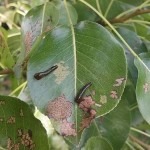While most babies are cute, cuddly and adorable, this is definitely not the case for the offspring of the Black Sawfly Caliroa cerasi. The larvae, known to us as Pear and Cherry Slugs, are possibly the ugliest of all pests, and the mess they make to some of our favourite fruit trees is pretty unattractive as well!
Description
 A beautiful deep, glossy black with a lighter coloured head, the Pear and Cherry slug grows to only 1cm in length and about 0.5cm wide. Mum is a Black Sawfly, a small, shiny, black wasp with a wingspan of 1 cm and a saw-like appendage with which she cuts leaves of the host plant to deposit her eggs.
A beautiful deep, glossy black with a lighter coloured head, the Pear and Cherry slug grows to only 1cm in length and about 0.5cm wide. Mum is a Black Sawfly, a small, shiny, black wasp with a wingspan of 1 cm and a saw-like appendage with which she cuts leaves of the host plant to deposit her eggs.
Plant Damage
The female sawfly deposits her eggs in a small slit in the leaves of her favourite trees in spring. After about 2 weeks, the slug-like larvae emerge, munching the leaves to a skeleton. Heavy infestations of slugs can cause serious defoliation, and result in incredibly unattractive and unproductive trees. They drop to the ground where they go through the pupal stage allowing another generation of flies to develop. Slugs will appear in early summer, and, after the next lot of pupae have spent winter in the soil, again the following spring.
Plants Affected
Pears (incl. ornamentals), cherries (incl. ornamentals), plums, quinces, apples, hawthorns and crabapples.
What to Do
- Blast them off the leaves with a strong jet of water and then band the tree with a low environmental impact horticultural glue.
- Make a deterrent spray by collecting and squashing slugs and placing in a bucket of boiling water. Once this has cooled, spray this on the leaves (including the undersides) of affected trees and scare those slugs away!
- Some recommend dusting the leaves with wood ash, but since most of us don’t have open fires to collect it from, try other powdery substances like chalk or flour. Talcum powder also works for some gardeners. Others have mixed fine builders’ lime (about a large handful in a bucket of water). It won’t dissolve so keep the sprayer agitated and remove any filters.
- Since sawflies pupate in the soil, adding wood ash – or even powdered lime – to the soil can help too. These substances may also benefit the soil if it is acid, but don’t add too much.
- Get a couple of chooks to scratch around the base of host trees over winter – they can’t resist the pupae napping in the soil!
- Create a diverse garden. This encourages predators like other flies, lacewings and wasps and they will all attract insectivorous birds. Plenty of shrubs and herbs with many small flowers will be just the answer.
Photo: Sharron Pfueller
Related Articles:
Garden Journaling – Slow down to tune in.
As we move through the year and our gardens evolve, there's something magical about documenting the journey. Garden journaling is an art that enables…
The Importance of building soil health for a biodeverse, productive garden
Creating a thriving garden that not only sustains itself but also contributes to the broader ecosystem requires more than just sunlight and water.…




